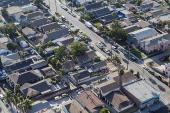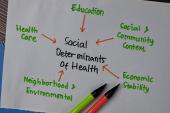Segregation Linked to Hypertension Among Black, Hispanic Individuals
But it seems certain neighborhood characteristics, such as safety and social cohesion, can blunt the impact.

Black and Hispanic people are more apt to develop hypertension if they live in segregated neighborhoods, according to an analysis of data from the Multi-Ethnic Study of Atherosclerosis (MESA). For Black individuals in particular, positive neighborhood qualities like safety and social support seem to somewhat buffer the risk posed by segregation.
This points to the need to better understand the impact of societal factors on disease, researchers say. “Addressing sociopolitical mechanisms that uphold structural racism, such as racial residential segregation, may be important to reduce racial and ethnic inequities in incident hypertension.”
The report, published recently in the Journal of the American Heart Association, is the latest contribution to growing evidence that demonstrates the connection between social determinants of health and cardiovascular disease. It follows, for instance, a study released late last year showing that for Black patients who experience an acute MI, living in a disadvantaged neighborhood—based on education, income, employment, and household characteristics—raises their risk of death in the years that follow hospital discharge.
Quinn Capers IV, MD (University of Texas Southwestern Medical Center, Dallas), chair of the American College of Cardiology’s diversity and inclusion committee, pointed out that while this study confirms earlier reports showing “an association between neighborhood segregation and cardiovascular morbidity, especially in Black and Hispanic communities,” it still offers new information.
Here, what’s “really novel” is that social environment—based on the community dweller’s rating of their own neighborhood’s safety, social cohesion, and aesthetic quality (ie, noise, litter, and attractiveness)—“modifies this association,” he told TCTMD in an email, “such that the positive correlation of neighborhood segregation on incident hypertension was blunted by a more-positive social environment. This appeared to be true only for Black individuals in segregated neighborhoods.”
Admittedly, he said, there is little that cardiologists can do “in the cath lab, the exam room, or on the inpatient ward” to address housing segregation.
“However, the doctor can encourage stress-relieving activities, like family gatherings, church attendance (if applicable to the individual), and if possible, travel to areas with green space and fresh air on a regular basis,” suggested Capers. “Finally, motivated physicians can engage in activism and advocate for legislation supporting fair housing and employment legislation.”
Hypertension Risk Increased by 33%
For the study, Xing Gao, MPH (University of California, Berkeley), and colleagues identified 1,937 MESA participants who lacked hypertension at baseline and identified as non-Hispanic Black (36.2%), Hispanic (40.6%), or Chinese (24.3%). Their mean age at the time of enrollment ranged from 58.0 to 59.4 years.
Average follow-up duration was 7.35 years. During this time, 65.5% of non-Hispanic Black, 48.1% of Chinese, and 53.7% of Hispanic participants developed hypertension.
The researchers used US census data to categorize the degree of segregation in the neighborhoods where each participant lived. They adjusted for numerous potential confounders: age, sex, education, birthplace within versus outside the United States, health insurance, income, and health-related factors (eg, smoking, physical activity, and body mass index).
Even with this adjustment, living in a segregated neighborhood raised the risk of developing hypertension for Black (HR 1.33; 95% CI 1.09-1.62) and Hispanic individuals (HR 1.33; 1.04-1.70). Chinese individuals showed a nonsignificant trend toward increased risk (HR 1.20; 95% CI 0.83-1.73).
MESA participants, as part of the original study, had been queried about their neighborhood environments. For Black individuals who lived in areas they perceived to be safer, be more aesthetically pleasing, and offer closer connection to neighbors, segregation had less impact on risk, “suggesting that better neighborhood social environment may buffer the deleterious influence of segregation on hypertension,” the researchers note.
“Greater social cohesion and sense of safety in a good neighborhood social environment,” they say, “may lessen chronic stressors, buffer the health consequences of experiencing interpersonal discrimination, and provide more access to community resources, which have been documented to be associated with hypertension risk and may be pathways through which segregation influences health.”
The same attenuation wasn’t seen among Hispanic and Chinese individuals, or when considering neighborhood physical environment, including the perceived availability of health food and walkability.
Even when adjusting for physical and social environment, segregation still had a significant link to hypertension risk among Black participants, “suggesting that segregation, as a manifestation of structural racism, may affect Black populations in ways that extend above and beyond the neighborhood environment,” Gao and colleagues write. They call for future studies to examine “the causal effects of segregation on cardiovascular health racial and ethnic inequities.”
These neighborhoods tend to be located in areas of high noise and air pollution, high violent crime rate, high density of fast food and liquor stores, and lack of green space and high-quality healthcare facilities. Quinn Capers IV
Capers set out numerous reasons why segregation would have such a strong effect on hypertension.
“While there are some segregated neighborhoods that are segregated ‘by choice,’—ie, middle-class Blacks choosing to live within proximity of one another—most Black and Hispanic segregated neighborhoods exist because of racist housing segregation laws,” he stressed. “These neighborhoods tend to be located in areas of high noise and air pollution, high violent crime rate, high density of fast food and liquor stores, and lack of green space and high-quality healthcare facilities. These factors would be predicted to lead to increasing incidence of high blood pressure.”
The attenuated link among Chinese participants may be due to smaller numbers, Capers noted. “It could also be due to the positive social contacts and cohesion seen among individuals living in immigrant neighborhoods, though that is just speculation.”
He hopes to see researchers tease out which specific activities and characteristics inspired a higher social environment rating. “Once validated, these findings could form the basis for recommendations for patients who reside in segregated neighborhoods,” said Capers.
Caitlin E. Cox is News Editor of TCTMD and Associate Director, Editorial Content at the Cardiovascular Research Foundation. She produces the…
Read Full BioSources
Gao X, Kershaw KN, Barber S, et al. Associations between residential segregation and incident hypertension: the Multi-Ethnic Study of Atherosclerosis. J Am Heart Assoc. 2022;10:e023084.
Disclosures
- Gao and Capers report no relevant conflicts of interest.





Comments